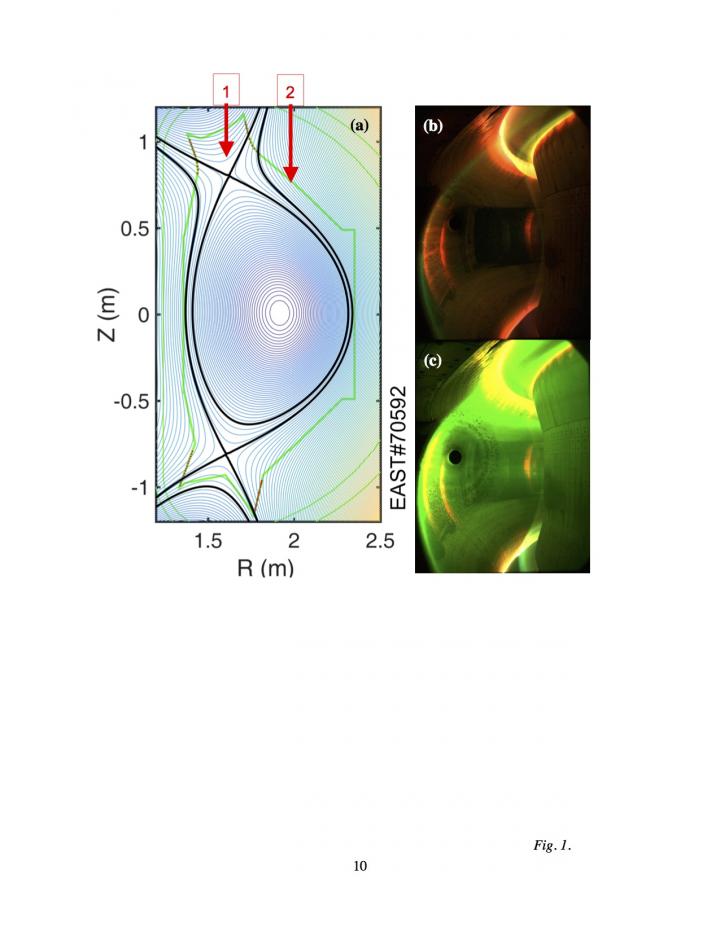Lithium — it's not just for batteries: It can also reduce instabilities in fusion plasmas

Figure showing the location of the two lithium injectors, as well as color images of plasma before and after lithium injection. Red indicates light emitted from both deuterium and lithium, while yellow and orange show lithium line emission. Credit: Rajesh Maingi
The results, demonstrated by scientists at the U.S. Department of Energy's (DOE) Princeton Plasma Physics Laboratory (PPPL) and collaborators on China's Experimental Advanced Superconducting Tokamak (EAST) found that lithium powder can eliminate instabilities known as edge-localized modes (ELMs) when used to coat a tungsten plasma-facing component called the “divertor” — the unit that exhausts waste heat and particles from plasma that fuels fusion reactions. If left alone, such instabilities can damage the divertor and cause fusion reactions to fizzle.
The results are good news for future devices that plan to use tungsten for their own divertors that are designed to work with lithium.
Past experiments with lithium powder on EAST have confirmed the metal's ability to eliminate or reduce the frequency and intensity of periodic bursts of ELMs that occur in the outer edge of plasmas that can damage the divertor.
ELMs develop regularly when the plasma enters a high-energy state known as high-confinement mode, or H-mode, which holds heat within the plasma more efficiently. ELMs can also unleash large amounts of heat that damage the plasma-facing components and release eroded material that can enter the plasma and cool the fusion reactions.
During the past experiments, EAST's upper and lower divertors were coated with light and porous carbon rather than the heavy metal tungsten. “So, the question was whether lithium will have the same effect on tungsten walls as it does with carbon walls,” said PPPL physicist Rajesh Maingi, lead author with Jiansheng Hu of the Institute of Plasma Physics at the Chinese Academy of Sciences (ASIPP) of a paper describing the results in the journal Nuclear Fusion.
The issue was in question because recent research on other doughnut-shaped tokamaks, such as the Axi-Symmetric Divertor Experiment-Upgrade (ASDEX-U) in Germany, have suggested that plasma-facing components made of tungsten actually reduce the ability of lithium coatings to control ELMs. Lithium was injected into ASDEX-U via large fast pellets, as compared with the lithium powder that was gravitationally injected into the EAST experiments.
In the recent experiments, researchers manipulated the plasma within EAST so that it exhausted its waste heat on the upper of the two divertors within the tokamak. Unlike the lower divertor, which was made of carbon, the upper divertor is fabricated from tungsten.
The results showed that lithium injected into plasma in contact with tungsten reduces ELMs just as much as lithium does when the plasma exhausts its heat on carbon. Physicists now have increased confidence that the techniques used to reduce ELMs in current fusion machines will be able to reduce ELMs in larger machines in the future, as long as they are designed to be compatible with lithium.
The research team noted that it became easier to eliminate ELMs as the experiments progressed, suggesting that elimination could require less lithium as time went on. Scientists would therefore like to find a way to regulate how much lithium is injected into the plasma, perhaps reducing the injection rate once the ELMs have disappeared to control the lithium inventory and optimize the performance of the plasma.
###
This research was funded by the DOE Office of Science together with the National Key Research and Development Program of China, the National Nature Science Foundation of China, and the National Magnetic Confinement Fusion Science Program of China. The team included scientists from PPPL, ASIPP, Johns Hopkins University, the Department of Applied Physics in China's Hunan University, Oak Ridge National Laboratory, and General Atomics.
PPPL, on Princeton University's Forrestal Campus in Plainsboro, N.J., is devoted to creating new knowledge about the physics of plasmas — ultra-hot, charged gases — and to developing practical solutions for the creation of fusion energy. The Laboratory is managed by the University for the U.S. Department of Energy's Office of Science, which is the largest single supporter of basic research in the physical sciences in the United States, and is working to address some of the most pressing challenges of our time. For more information, please visit science.energy.gov
Media Contact
All latest news from the category: Physics and Astronomy
This area deals with the fundamental laws and building blocks of nature and how they interact, the properties and the behavior of matter, and research into space and time and their structures.
innovations-report provides in-depth reports and articles on subjects such as astrophysics, laser technologies, nuclear, quantum, particle and solid-state physics, nanotechnologies, planetary research and findings (Mars, Venus) and developments related to the Hubble Telescope.
Newest articles

NASA: Mystery of life’s handedness deepens
The mystery of why life uses molecules with specific orientations has deepened with a NASA-funded discovery that RNA — a key molecule thought to have potentially held the instructions for…

What are the effects of historic lithium mining on water quality?
Study reveals low levels of common contaminants but high levels of other elements in waters associated with an abandoned lithium mine. Lithium ore and mining waste from a historic lithium…

Quantum-inspired design boosts efficiency of heat-to-electricity conversion
Rice engineers take unconventional route to improving thermophotovoltaic systems. Researchers at Rice University have found a new way to improve a key element of thermophotovoltaic (TPV) systems, which convert heat…



